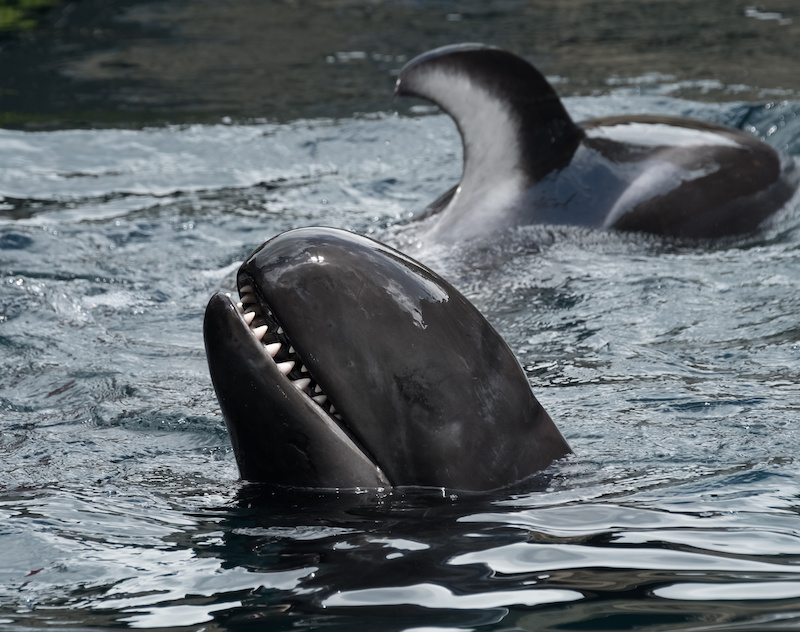
The False Killer Whale, often called the false killer whale, is an intriguing marine mammal that arouses both curiosity and admiration. In this article, we explore in detail the unique characteristics of the False Killer Whale, its natural habitat, reproduction habits, and diet. Discover the secrets of this large dolphin, often overshadowed by its more famous cousins, and dive into the fascinating world of these majestic creatures.
Characteristics of the False Killer Whale
The False Killer Whale, or Pseudorca crassidens, is a fascinating member of the Delphinidae family, distinguished by several unique traits. Among the largest in their family, these marine mammals can reach an impressive length of 6 meters for males and 5 meters for females, with a weight of up to 2.2 tons for males and 1.2 tons for females. Their remarkable longevity can extend up to 60 years, demonstrating their resilience in the marine ecosystem.
Morphologically, the False Killer Whale has an elongated and slender body, with a characteristic conical head and a rounded melon. It is distinguished by the absence of a beak , a rare feature among cetaceans. Its powerful jaws are equipped with 16 to 24 teeth per jaw, each measuring up to 8 cm in length. The dorsal fin of the False Killer Whale is large and sickle-shaped, positioned in the middle of the back, while its pectoral fins are long and pointed.
The coloration of the False Killer Whale varies from black to dark gray, with a lighter M-shaped patch between the pectoral fins and the genital area. This coloration allows it to effectively camouflage in the ocean depths. In terms of behavior, the False Killer Whale is known for its sociable nature and ability to swim rapidly, often observed surfing, porpoising, and performing spectacular leaps like the Martinique dolphins. These characteristics, combined with its diverse diet and role as a predator in the marine ecosystem, make the False Killer Whale a key species in the oceanic food chain.

Habitat of the False Killer Whale
The False Killer Whale (Pseudorca crassidens) primarily inhabits the deep waters of tropical and temperate oceans , with a notable presence in the Pacific and Indian Oceans. These marine mammals prefer deep marine areas, typically between 200 and 2000 meters, where they find a food-rich environment suitable for their lifestyle.
Despite their preference for depths, False Killer Whales can occasionally be observed in shallower waters, including near coastlines. Their remarkable ability to adapt to different marine environments allows them to navigate and hunt in a wide range of oceanic conditions. This habitat flexibility is crucial for their survival, enabling them to exploit various food resources and adapt to environmental changes. The False Killer Whale, with its sociable behavior and curious nature, is often seen riding the bow waves of boats, demonstrating its interest in human activity and agility in the water.
Reproduction in the False Killer Whale
The reproduction of the False Killer Whale (Pseudorca crassidens) is a complex and fascinating process. These cetaceans reach sexual maturity between 8 and 12 years old, a relatively late age compared to other dolphin species. Gestation in the False Killer Whale lasts between 14 and 16 months, a longer period than in most other cetaceans, reflecting the size and complexity of fetal development. After birth, the female gives birth to a single calf, which she will nurse and care for for about 18 months.
Complete weaning usually occurs around the age of 2 years. The intervals between births are long, often spaced 7 years apart, emphasizing the significant investment of the mother in each offspring. This reproductive strategy, focused on intensive and prolonged care of the young, is crucial for the survival of the species, ensuring that each calf has a strong chance of survival and maturity.

Diet of the False Killer Whale (Pseudorca crassidens)
The False Killer Whale (Pseudorca crassidens) is a formidable and versatile predator with a diverse diet adapted to its oceanic environment. These cetaceans primarily feed on **fish and cephalopods**, with a preference for **larger species such as bonito and tuna**. Their ability to hunt in groups enables them to effectively target larger and faster prey.
In addition to fish, False Killer Whales **also consume squid**, adding significant variety to their diet. Occasionally, they may prey on other marine mammals, including small dolphins, demonstrating their adaptability and proficiency as hunters. Their rich and varied diet is essential for maintaining their large size and activity level, playing a crucial role in the ecological balance of the oceans by regulating the populations of their prey.
Discover all the species of cetaceans that can be found near the coasts of Martinique: